Many riders who aren't so tall or ladies just starting to ride bikes need to pick out the best Motorcycles for Short Riders and Women. They gotta look for three key things: a seat that's not too high up, a bike that's not too heavy, and something that looks good enough to give them confidence. […]
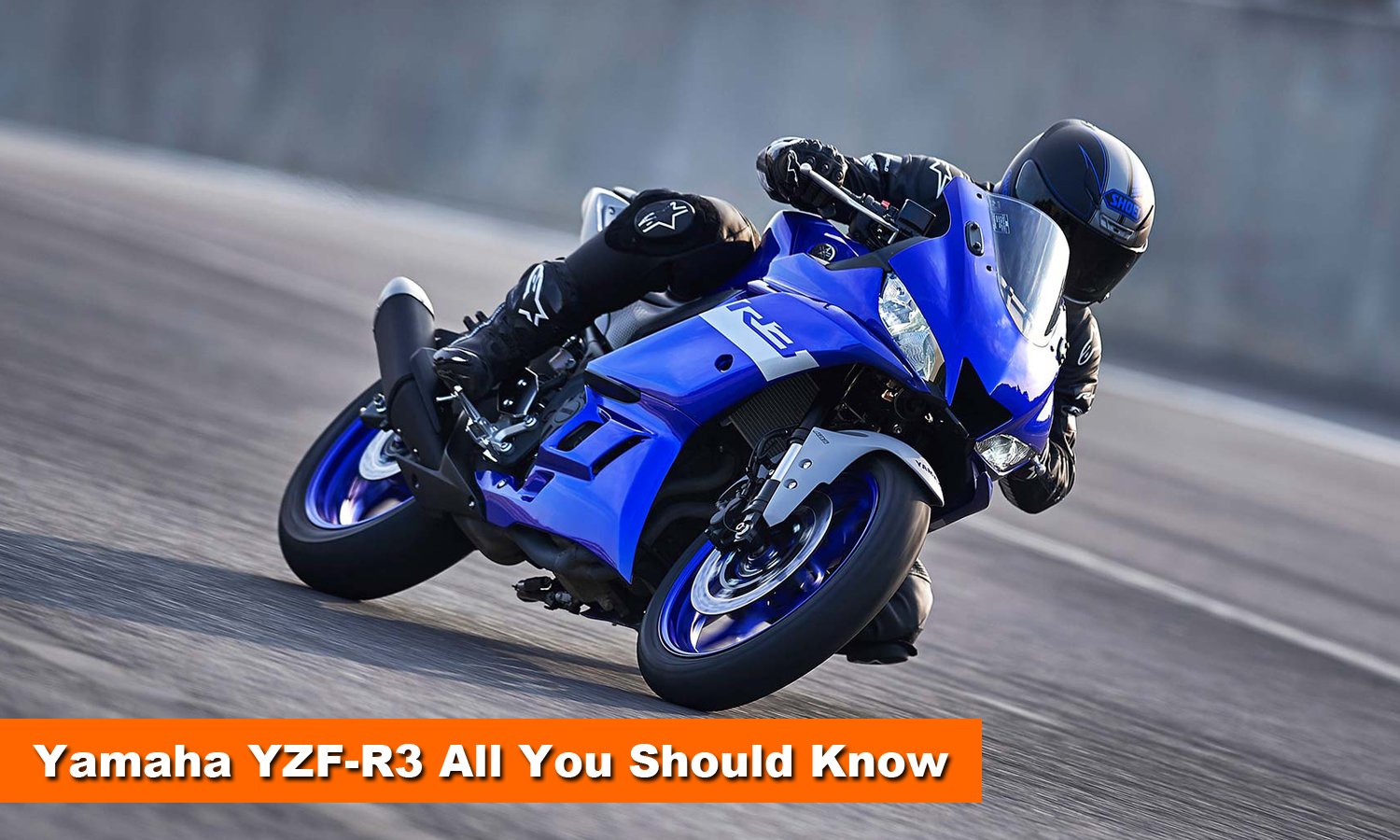
Yamaha YZF-R3 All You Should Know 2024
Table of Contents
1. Introduction to Yamaha YZF-R3
The realm of entry-level sportbikes has witnessed a surge of contenders vying for the throne. Each of them promises an unparalleled blend of exhilaration and accessibility.
Among these formidable challengers stands the Yamaha YZF-R3. It has garnered significant attention for its striking aesthetics and tantalizing performance credentials.
In this comprehensive exploration, we delve into the heart of this lightweight two-cylinder marvel.
We will deeply dissect its acceleration prowess, top-speed capabilities, and the factors that contribute to its thrilling ride experience.
2. Enter the Entry-Level Sportbike Market
Kawasaki and Honda had already established their presence in the low-capacity sportbike segment. But Yamaha recognized the growing demand for accessible performance machines.
Yamaha's legendary 'R' series revered models like the R1 and R6 have won success in the market. Capitalizing on them, Yamaha sought to introduce an entry-level offering that would resonate with aspiring riders.
Finally, the Yamaha YZF-R3 appears in the world.
3. The Birth of the YZF-R3: A Formidable Contender Emerges
In 2015, Yamaha unveiled the YZF-R3. It is a motorcycle that aimed to dethrone the reigning champion in the entry sportbike category – the Ninja 300.
Compared to the Ninja 300's 296cc engine, the YZF-R3 boasts a larger 321cc parallel twin-cylinder engine. This makes sure the R3 is able to deliver an edge in power and torque output.
Despite its larger displacement, Yamaha's engineering prowess shone through. Because, the R3 tipped the scales at a svelte 167 kg dry weight, undercutting its main rival by a substantial 7 kg.
4. Main Specifications
| Parent company | Yamaha Corporation |
|---|---|
| Production | 2015–present |
| Assembly | Indonesia: Karawang, West Java (Yamaha Indonesia Motor Manufacturing) Brazil: Guarulhos, São Paulo (Yamaha Motor da Amazônia) (since 2022) |
| Class | Sport bike |
| Engine | 320.3 cc (19.55 cu in) liquid-cooled 4-stroke 8-valve DOHC 180° inline-twin |
| Bore / stroke | 68.0 mm × 44.1 mm (2.68 in × 1.74 in) |
| Compression ratio | 11.2:1 |
| Top speed | 181 km/h (112 mph) (Estimated) 166 km/h (103 mph) |
| Power | 31 kW (42 hp) @ 10,750 rpm (claimed) 27.4 kW (36.7 hp) @ 10,750 rpm (rear wheel) |
| Torque | 21.8 lb⋅ft (29.6 N⋅m) @ 9,000 rpm (claimed) 19.8 lb⋅ft (26.8 N⋅m) @ 9,100 rpm (rear wheel) |
| Transmission | 6-speed constant mesh |
| Frame type | Steel diamond |
| Suspension | Front: 41 mm telescopic fork Rear: swingarm |
| Brakes | Front: Single 298 mm hydraulic disc Rear: Single 220 mm hydraulic disc |
| Tires | Front: 110/70-17H Rear: 140/70-17H |
| Rake, trail | 25°, 95 mm (3.7 in) |
| Dimensions | L: 2,090 mm (82 in) W: 720 mm (28 in) H: 1,135 mm (44.7 in) |
| Seat height | 780 mm (31 in) |
| Weight | 167 kg (368 lb) (wet) |
| Fuel capacity | 14.0 L (3.1 imp gal; 3.7 US gal) |
| Oil capacity | 2.1–2.4 L (2.2–2.5 US qt) |
| Fuel consumption | 4.2–4.9 L/100 km; 67–58 mpg‑imp (56–48 mpg‑US) |
| Related | Yamaha MT-03 Yamaha YZF-R25 |
5. Engine Performance
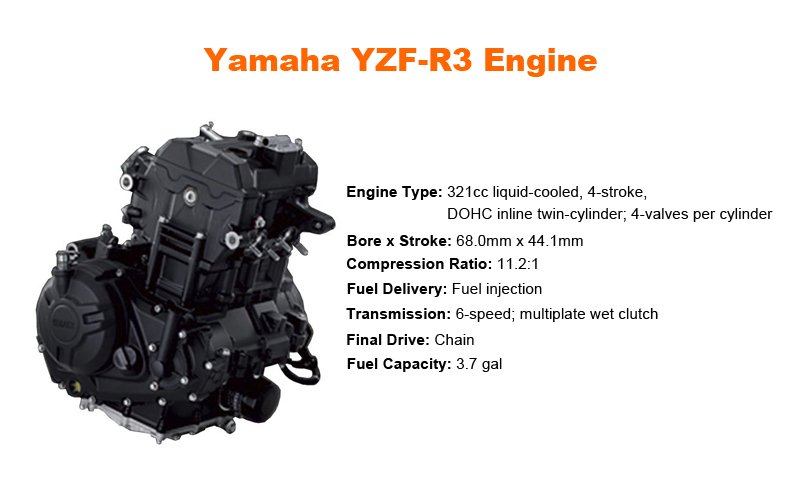
Yamaha YZF-R3 engine
At the core of the Yamaha YZF-R3 lies a potent 321cc parallel twin-cylinder engine. It can deliver a respectable 37 horsepower at 10,500 rpm and 20 lb-ft of torque at 9,000 rpm at the rear wheel.
These figures position the R3 squarely in the mid-range of the 250-500cc beginner sports motorcycle class. Thus, this engine offers a compelling balance of power and tractability.
One of the standout features of the R3's engine is its ability to produce peak torque remarkably close to its peak power output. It is only a 1,500 rpm difference separating the two.
This characteristic translates into a broad and accessible powerband. And, ensures that the engine's sweet spot remains within reach across a wide range of riding scenarios.
6. Acceleration Prowess
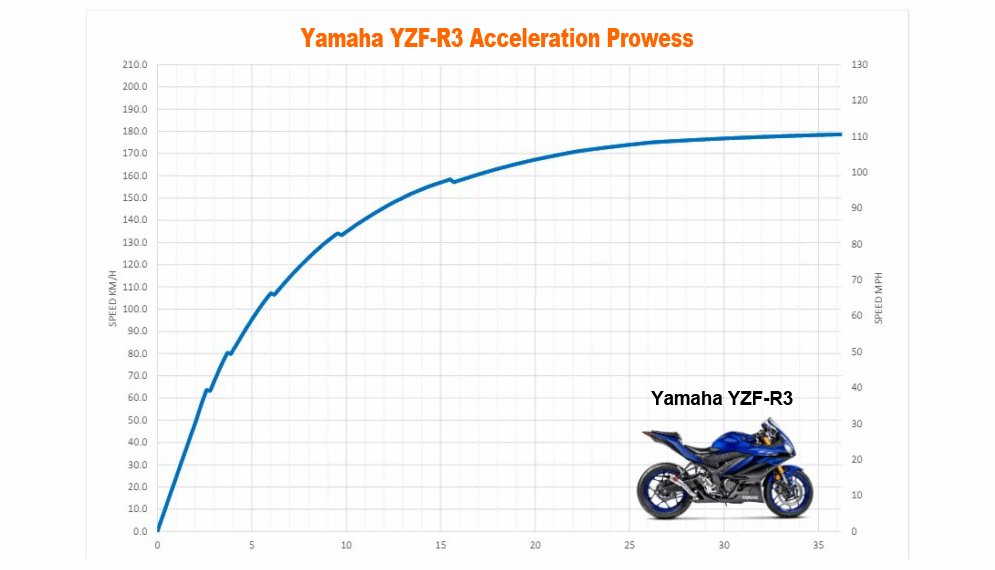
acceleration prowess of Yamaha YZF-R3
The Yamaha YZF-R3's acceleration capabilities are impressive, especially when considering its entry-level positioning.
From a standstill, the R3 can sprint from 0 to 60 mph in a blistering 5.1 seconds. Besides, its 0 to 100 mph benchmark is achieved in a remarkable 17.13 seconds.
These figures outpace its direct rivals like the Ninja 300, but it is not the end. It is also challenging the performance of larger, more powerful machines such as the restricted A2/LAMS CBR650R.
The R3's quarter-mile performance is also noteworthy, with a time of 14 seconds flat and a terminal speed of 95 mph.
This level of straight-line performance is sure to ignite the adrenaline of even the most seasoned riders. With skills progress, the YZF-R3 will offer more tantalizing tastes of the exhilaration.
7. Top Speed of the Yamaha YZF-R3
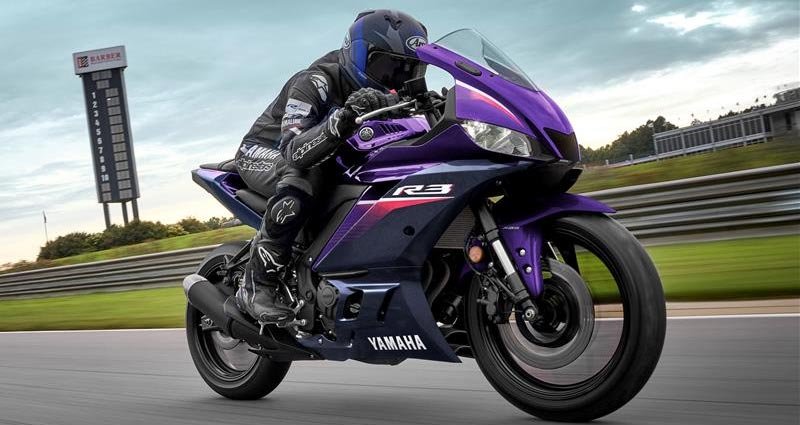
the top speed of Yamaha YZF-R3
The outright top speed is often not the primary focus for starter sportbikes. But, the Yamaha YZF-R3 surprises with its capability to reach dizzying heights.
With a rider tucked in and holding on tight, the R3 can achieve a top speed of 112 mph(181 km/h). This is a figure that exceeds expectations for a machine in its class.
Under favorable conditions, such as a tailwind or a slight decline, the R3 can even flirt with the 120 mph mark, kissing the limiter in sixth gear.
8. Gearing and Shift Points
To extract the most from the Yamaha YZF-R3's performance potential, it's essential to understand its gearing and optimal shift points.
The R3's gearbox is designed to deliver consistent acceleration times when upshifting between 10,500 and 12,000 rpm. Thus allowing riders to find their preferred sweet spot without sacrificing performance.
The R3's acceleration figures can vary based on factors such as rider weight, wind conditions, and terrain. This is a common feature among many low-displacement motorcycles.
A lighter rider or a tailwind can enhance acceleration times. But a heavier rider or a headwind may slightly diminish performance.
However, the R3's lightweight and responsive nature reduced this impact. Even minor variations in conditions will have a less pronounced impact compared to higher-powered machines.
9. Handling and Agility: Mastering the Corners

handling and agility performance of YZF-R3
The straight-line performance of the Yamaha YZF-R3 is undoubtedly impressive. But, the true thrill of YZF-R3 lies in its ability to carve through corners with precision and agility.
The bike's lightweight construction and well-balanced chassis contribute to its nimble handling characteristics. So the riders can confidently navigate twisty roads and tight urban environments.
10. Braking Performance
Complementing the R3's acceleration and handling prowess is its capable braking system.
Some critics have noted that the front brake could benefit from additional bite, particularly during aggressive riding. But, I'd like to say, the overall braking performance remains reassuring and confidence-inspiring.
Yamaha has addressed this concern by offering aftermarket upgrades like steel-braided brake lines. This can further enhance the braking feel and responsiveness.
Besides, the R3's lightweight construction aids in its ability to shed speed effectively. Riders can scrub off velocity with confidence when approaching corners or navigating urban areas.
11. Suspension Setup
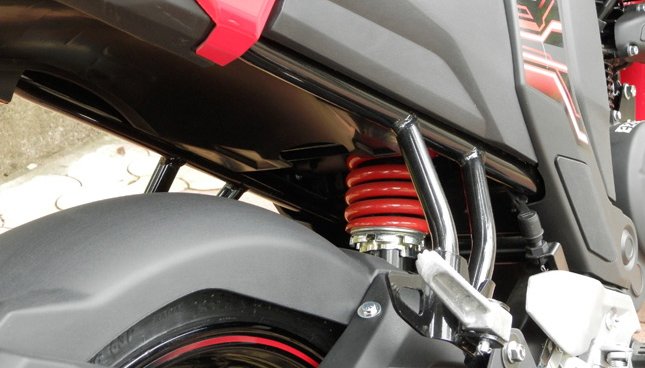
suspension setup of YZF-R3
The Yamaha YZF-R3's suspension setup strikes a balance between comfort and performance. This makes sure it definitely caters to the diverse needs of entry-level riders.
The YZF-R3's suspension may lack the extensive adjustability found on higher-end models. But its well-tuned characteristics provide a compliant ride quality for daily commuting and recreational riding.
For those seeking more advanced performance, the R3's suspension can also be upgraded. Riders can fine-tune the bike's handling to suit their preferences and riding styles.
12. Ergonomics and Comfort
One of the standout features of the Yamaha YZF-R3 is its ergonomic design. That's because it prioritizes comfort without compromising its sporting aspirations.
The slightly raised clip-on handlebars and upright seating position contribute to a less aggressive riding posture. Also, this can reduce strain on the wrists and lower back during extended journeys.
Besides, the R3's narrow tank and low 30.7-inch seat height enhance accessibility for riders of varying heights.
So, it is an appealing choice for those seeking a confidence-inspiring and comfortable starter sports bike.
13. Styling and Aesthetics
Yamaha's designers have masterfully blended form and function with the YZF-R3. Finally, they created a motorcycle that commands attention wherever it goes.
The bike's aggressive styling cues, inspired by its larger 'R' series siblings, exude a sporty and muscular presence that belies its entry-level positioning.
From the aerodynamic fairing to the sleek and sculpted tank, every aspect of the R3 exudes a sense of purpose and dynamism.
This visually striking appearance directly appeals to the aesthetic sensibilities of riders. What's more, it reminds us of the exhilarating performance that lies beneath the surface.
14. Customization and Personalization
The Yamaha YZF-R3 offers a vast array of aftermarket accessories and customization options.
Rides can choose performance upgrades like exhaust systems and engine tuning. Also, cosmetic enhancements like graphics kits and color-matched components are also acceptable.
Riders can tailor their R3 to reflect their unique personalities and riding preferences.
This level of customization enhances the bike's performance and appearance. Moreover, it fosters a deeper connection between the rider and the machine.
With these customization, the R3 will transform into a truly personalized extension of one's individuality.
15. Pros and Cons
Pros
- User-Friendly: Great for beginners with its manageable power and easy handling.
- Lightweight: Offers nimble maneuverability, ideal for city riding.
- Reliable: Known for durability and low maintenance issues.
- Sporty Design: Attractive styling with a modern look.
- Affordable: Competitive price for a sportbike, with good resale value.
Cons
- Limited Power: May not satisfy those seeking high-speed thrills.
- Comfort: Long rides can become uncomfortable due to the sporty seating position.
- Basic Features: Lacks some advanced tech found in higher-end models.
- Wind Protection: Limited fairing may not offer full wind protection on highways.
16. Frequently Asked Questions
#1. Is the Yamaha YZF-R3 fast?
Yes, the R3 is fast enough to be exciting, but still approachable for newcomers.
The Yamaha YZF-R3 is a popular entry-level sportbike known for its speed and agility. Its 321cc twin-cylinder engine provides a good balance of power for new and experienced riders.
This sportbike can reach a top speed of around 112 mph (181 km/h). Thus making it fast enough for most road conditions and some track riding.
Besides, its lightweight design and responsive handling make it easy to maneuver. Even if you are riding it in city traffic or on twisty roads, it is still easy to control.
It's a great choice for those looking to start with a manageable, yet thrilling motorcycle.
#2. Why is R3 so expensive?
The Yamaha R3 can seem expensive due to several factors:
- It's built with high-quality materials and advanced engineering to ensure reliability and performance.
- The bike features a sporty design and modern technology, such as ABS and a digital display, which add to its cost.
- Yamaha is a reputable brand known for durability and strong resale value. This also contributes to the price.
- Manufacturing and import costs, taxes and dealer fees can increase the overall price.
While it may seem costly, the R3 offers a solid balance of performance, style, and brand assurance.
#3. Is R3 a super bike?
The Yamaha YZF-R3 is not classified as a superbike.
Superbike typically refers to high-performance motorcycles with engines over 1000cc. These bikes are designed for extreme speed and power.
The R3, with its 321cc engine, is an entry-level sportbike.
It's designed for beginner to intermediate riders who want a sporty feel without the overwhelming power of a superbike.
The R3 offers a good balance of performance, agility, and ease of handling. It's great for city riding, commuting, and learning the basics of sport riding.
While not a superbike, the R3 provides an exciting and accessible experience for many riders.
#4. Is the Yamaha YZF-R3 comfortable?
Yes. The Yamaha YZF-R3 is relatively comfortable for a sportbike.
It has a more upright seating position compared to more aggressive sport models. This helps reduce strain on the wrists and back.
The seat is designed to be accommodating for both short rides and longer commutes.
Its lightweight and nimble handling make it easy to control in city traffic, enhancing overall comfort.
But, like many sportbikes, long rides might still lead to some discomfort due to its sporty stance.
For daily use and shorter trips, the R3 strikes a good balance between performance and comfort. That's why it is a popular choice for many riders.
#5. Is the Yamaha R3 reliable?
Yes, the Yamaha R3 is known for its reliability. Yamaha has a strong reputation for building durable and dependable motorcycles.
The R3's 321cc engine is well-engineered for consistent performance and longevity. Regular maintenance, such as oil changes and chain adjustments, helps keep it running smoothly.
Many riders appreciate its solid build quality and minimal issues over time. Parts and services are generally accessible, making upkeep manageable.
Overall, the R3 is a reliable choice for both new and experienced riders. Because it offers peace of mind with its dependable design and proven track record.
17. Conclusion:
The Yamaha YZF-R3 is a testament to the brand's commitment to delivering accessible performance and unparalleled riding excitement.
It is equipped with potent engine, impressive acceleration capabilities, and agile handling characteristics. Based on these advanced techs, this entry-level sportbike offers a tantalizing taste of the thrills. Riders can progress along their two-wheeled journey with this best sports motorcycle.
If you're a newcomer seeking an exhilarating introduction to the world of sportbikes, try the YZF-R3. If you are an experienced enthusiast seeking a lightweight and nimble companion for urban exploration or weekend adventures, it can also meet your demand.
Anyway, the Yamaha YZF-R3 promises to deliver an unforgettable ride experience.
Embrace the thrill, and unleash your passion now! Join the ranks of those who have discovered the exhilarating world of the Yamaha YZF-R3.

Motorcycle mechanic, writer. Interested in motorcycle gear for years. Like to stay up to date with the newest products and techniques of the motorcycle.
As we accelerate into 2025, motorbikes are getting a serious tech upgrade. They’re all about safer rides and more fun on the road. Even if you’re a pro or just starting, kitting out your two-wheeler with cool tech stuff is a game-changer. Check out these ten top motorcycle gadgets each motorcyclist will want in 2025. […]
Getting around the city every day can be super annoying. You've got traffic like molasses nowhere to park, fuel prices through the roof, and buses stuffed like sardine cans make heading to the office a real pain. For loads of folks, getting a motorcycle is a pretty slick move—they’re nimble, cost-effective, and perfect for squeezing […]
Rider safety demands motorcycle helmets. Yet, riders still clash over picking full-face vs open-face helmets. Full-face ones take the win for protecting in crashes, but open-face models charm folks who want cool looks better air, and that old-school vibe. This guide dives into the latest research, technological advancements, and real-world insights to help you decide […]
Fodsports FX 60C vs FX30C Pro: What's new techs are the FX 60C bringing to us? Fodsports is a brand worth-mention for helmet communication and video recording. This brand has established itself as a key player with its innovative Bluetooth camera intercom systems. Recently, Fodsports has released a new camera intercom, the FX 60C. How […]
The Fodsports FX 60C is leading a revolution in the Bluetooth camera intercoms market. This 2025 newest intercom with camera by Fodsports is designed to enhance your riding experience. This device comes with advanced features like Bluetooth 5.4, 4K HD recording, 10-way intercom, and plenty more. So it is clear that this device seamlessly blends […]

